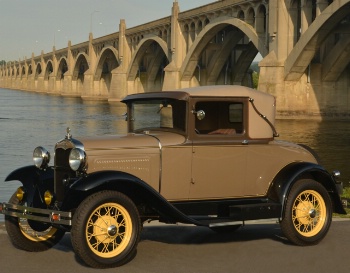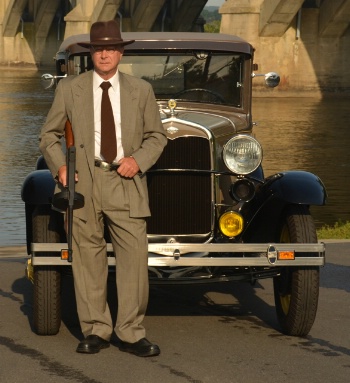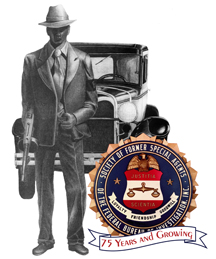G-Man and the Model A
by John Kutz (1971-1996)
(reprinted with permission: from Model A News, October 2012)
The first time I saw the 1931 Model A Ford Sport Coupe was in August of 1988 shortly after I was transferred to the two man FBI satellite office (known as a Resident Agency) located in Havre de Grace, MD. Assignment to a Resident Agency is highly desirable to many FBI Agents since it offers a variety of work and the ability to operate independently of the main FBI Field Office. I had been an FBI Special Agent for 17 years and had worked in two large Field Offices. I had been on the list for Resident Agency assignment for nine years. In my career, I had worked most of the 200+ Federal Criminal and Counterintelligence categories under FBI investigative jurisdiction. I was ready for the assignment.
 During the first week in the new office, the agent I replaced took me on an orientation ride around the coverage area which was Harford County and part of Cecil County, MD. Harford County is home to the huge U.S. Army Base, Aberdeen Proving Ground (APG) and Edgewood Arsenal. Much of the work at APG and Edgewood is classified. At that time, there were about 10,000 military and civilian workers on the base. It was also home to about 10,000 military and dependents. The FBI, along with the Military Police, had exclusive jurisdiction over criminal violations occurring on the base. The FBI and the local Military Intelligence group shared counterintelligence and counterterrorism investigative work.
During the first week in the new office, the agent I replaced took me on an orientation ride around the coverage area which was Harford County and part of Cecil County, MD. Harford County is home to the huge U.S. Army Base, Aberdeen Proving Ground (APG) and Edgewood Arsenal. Much of the work at APG and Edgewood is classified. At that time, there were about 10,000 military and civilian workers on the base. It was also home to about 10,000 military and dependents. The FBI, along with the Military Police, had exclusive jurisdiction over criminal violations occurring on the base. The FBI and the local Military Intelligence group shared counterintelligence and counterterrorism investigative work.
After touring the county and APG, I met one of our contacts on the base, Dick Greider, who was working as a civilian employee for the 902nd Military Intelligence Group. Dick knew everyone at APG from the janitors to the commanding Generals. He was an indispensable resource for anything happening on the base. Dick joined the Army shortly after graduating from North Harford High School in 1958 and retired as a Warrant Officer. Dick and I became friends almost immediately. We had similar professional backgrounds and interests although we worked for different agencies. Dick had more "hands on” operational experiences than I did so I learned a great deal from him.
In the spring of 1989, Dick invited my wife and I to his small farm in northern Harford County, MD, for a Sunday visit. It was during the tour of the livestock buildings and equipment that I spotted the little Model A Sport Coupe tucked away in a corner of a large outbuilding. He told me his mother bought it in 1956 so he and his sister would have a car to drive to high school. He parked it in the barn when he joined the Army. My first car was a 1930 Model A Ford Tudor which I bought in 1962 and drove to high school my senior year in 1964. By coincidence, we had another experience in common. I mentioned to him that day, if he ever wanted to sell it, I would be interested. He said he planned to restore it but his job and the farm responsibilities kept him from doing so over the years.
In 1992, I was transferred to FBI Headquarters in Washington, DC, from the Harford County assignment. My family was happy living in Bel Air, MD, so I elected to endure the 140 mile round trip commute to Washington DC everyday. Dick and I stayed in contact over the years and continued to swap stories over an occasional Saturday morning breakfast at a local diner. Dick retired from his civilian Army job shortly after I retired from the FBI in 1996, however, I continued to work for contractors in the DC area until 2005. In April 2000, Dick and I got together for one of our Saturday morning breakfasts at the local diner. Out of the clear blue, he said he wanted to sell the Ford and wondered if I was still interested. We had not talked about the car for 10 years. I said "yes” before thinking that I needed to clear such a purchase and future project with my wife. The last Model A Ford I had and worked on was in 1965. It was a 1929 AA truck also stored in a barn for over 30 years.
 Dick and I agreed on a price. I went home trying to think of how I could tell my wife that I just bought a 70-year-old car that did not run and that would force her car to sit outside on the driveway while I worked on it. She was skeptical at first, but, when she saw it, her only comment was, "It’s adorable." I had the green light and started evaluating it for restoration.
Dick and I agreed on a price. I went home trying to think of how I could tell my wife that I just bought a 70-year-old car that did not run and that would force her car to sit outside on the driveway while I worked on it. She was skeptical at first, but, when she saw it, her only comment was, "It’s adorable." I had the green light and started evaluating it for restoration.
Work began immediately and, within two weeks, I had the entire car dismantled. I had high hopes that the car would be finished within a year. Little did I know that it would be ten and a half years before the car would run on its own again. I had all the usual road blocks thrown in my path keeping me from working on it. There was the full time job, an accident with a broken back, buying a farm in Pennsylvania, rebuilding a house, barn and garage, moving to the farm and, of course, the quadruple heart bypass. All of this slowed the restoration project. Finally, in May 2011, I drove the Ford out of the garage under its own power – just in time for its 80th birthday. The car is a late 1931 with a re-stamped 1930 firewall. The body number indicates it was built in the Norfolk plant in late May 1931. I was advised that Ford only used the re-stamped firewalls on the first few cars built in late May 1931, when they converted to the new indented firewall design. It seems that Henry never wasted anything. The original upholstery was discovered under the yellow 1950s vinyl re-upholstery job along with an original key; 1917, 1930, and 1942 pennies; 1924 and 1942 dimes; and a 1947 nickel. There was evidence that hundreds of generations of mice had called the Ford home, too. I was blessed to have the finest paint and body man in southeast Pennsylvania, Shawn Emenheiser, just a half mile down the road. Shawn is truly an artist as the final product testifies. Dick had painted the car yellow in the late 50's. The original color was almost gone, but there was some evidence that it was Kewanee green. My wife and I chose the Chicle/Cobra Drab combo with Tacoma Cream wheels. As I was about to complete the car, I joined MARC and the Susquehanna Valley Chapter. Our club is active with many members ready to lend suggestions and assistance to restorers. Unfortunately, Dick passed away in 2002 after a brief illness and never saw his old high school car back on the road.

In December 2012, I received my monthly copy of the Grapevine, the magazine of the Society of Former Special Agents of the FBI. The Society of Former Special Agents of the FBI is a private 501 (c)(7) non-profit organization and is not a part of the FBI or affiliated in any way with the Model A Restorers Club. I have been a member of the former Agents' Society since 1996. The Society chose a new logo for the 75th anniversary of the organization’s founding. The new logo includes the iconic "G-Man” statue, the Society’s seal, and, to my amazement, an image of the front of my car. I immediately contacted the editor of the Grapevine and asked about the selection of a Model A Ford for the logo. She said the car "just looked right” to back up the G-Man statue for the new logo. My hobby and former profession came together this year. Driving the car brings back many memories from high school, a very fulfilling career, and, most importantly, a great friend.